The main street is filled with crowds of backpackers, restaurants, bars, and tour companies. Away from the main street it’s a sweet easy pace, probably much the same as it has been for decades, where people still embrace traditional ways, both at home and on the farm, except that here, in a way that is quite different from anywhere else in Cuba, they are made relatively wealthy from tourism. It seems like a fortunate melding of the best of both worlds.
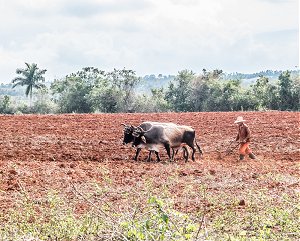 We booked a tour of the valley through the tobacco farms with a local farm worker. It turned out to be one of our best days in Cuba. The day before we’d stood in line in a tourist agency on the main street. We didn’t know if it would even be possible, but we wanted to get off the roads and tour the valley in one of the local horse-drawn carts. We didn’t want a tourist buggy. We wanted to go with a farmer in one of the unique carts they use in the region.
We booked a tour of the valley through the tobacco farms with a local farm worker. It turned out to be one of our best days in Cuba. The day before we’d stood in line in a tourist agency on the main street. We didn’t know if it would even be possible, but we wanted to get off the roads and tour the valley in one of the local horse-drawn carts. We didn’t want a tourist buggy. We wanted to go with a farmer in one of the unique carts they use in the region.
The province of Pinar del Rio occupies the westernmost end of Cuba as it curves gently towards Mexico. The very best tobacco in the world is grown here and the cigars made from this tobacco are an iconic and world-renowned part of Cuban culture. The rugged mogotes or limestone bluffs, the red earth, the lush green of the plants, and the plows pulled by a pair of oxen and steered by a vaquero all tell us we have arrived in the real Viñales, the Viñales of the local tobacco farmer.
Viñales in the second most visited place in Cuba after Havana, and it’s not hard to understand why. Activities range from rock climbing, to horseback riding, to caving, to hiking, in some of the most spectacular scenery in the world. But it’s more than that: there’s something special about the place. There’s a relaxed easy feeling that’s missing in the city, as if peace arises from the earth itself and everybody is invited to take a share. We loved it there and could have happily stayed longer.
From Viñales we took a bus to Trinidad. It was a long, but uneventful day.
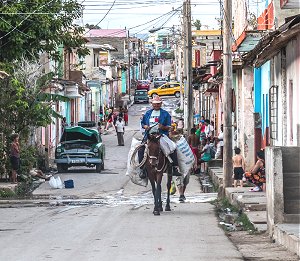 In Trinidad we stayed in a lovely casa in the “suburbs”, meaning outside of the beautifully restored Spanish Colonial centre. The suburbs are poor and crumbling and rough at first glance, but our casa was clean and comfortable, the food was good enough, our hosts delightful, and the people of the neighborhood welcoming and friendly.
In Trinidad we stayed in a lovely casa in the “suburbs”, meaning outside of the beautifully restored Spanish Colonial centre. The suburbs are poor and crumbling and rough at first glance, but our casa was clean and comfortable, the food was good enough, our hosts delightful, and the people of the neighborhood welcoming and friendly.
The city is one of Cuba’s foremost tourist destinations, mainly because the centre, a few square blocks of cobblestone streets, is a well-maintained Unesco World Heritage site showcasing a Spanish Colonial town of finest quality. It was built on the backs of the slave trade and the sugar trade. People amassed huge fortunes and built expansive, and expensive, plazas, mansions, and churches. Plaza Mayor, an open-air museum, is surrounded by impeccable examples of the architecture of the time.
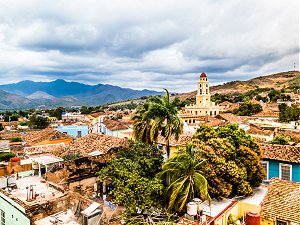 During our days in Trinidad we wander in and out of the various mansions and museums. There are frescoed walls, marble statues, Sèvres vases, furniture embedded with delicate mother-of-pearl, Baccarat crystal, Wedgewood china, French chandeliers, and exquisitely embroidered lace. Although now a little faded and dusty, it is still a testament to the staggering wealth of the time. In the early 1800’s, when sugar farming was at its peak, there were about sixty sugar mills in the area, and 30,000 slaves.
During our days in Trinidad we wander in and out of the various mansions and museums. There are frescoed walls, marble statues, Sèvres vases, furniture embedded with delicate mother-of-pearl, Baccarat crystal, Wedgewood china, French chandeliers, and exquisitely embroidered lace. Although now a little faded and dusty, it is still a testament to the staggering wealth of the time. In the early 1800’s, when sugar farming was at its peak, there were about sixty sugar mills in the area, and 30,000 slaves.
There are some nice restaurants in the centre, and a good place to hang out is on the steps leading up to the Casa de la Musica with locals and tourists alike. It’s the town’s best Wi Fi hotspot, and it comes alive at night with music and salsa dancing.
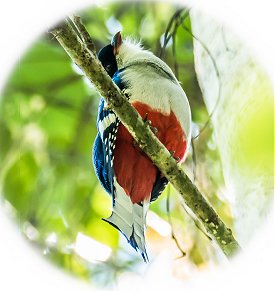 We went on three day trips from Trinidad, all easily arranged with a travel agency in the centre: we visited an abandoned sugar mill out in the Valle de los Ingenios. The biggest draw for us was the slow train trip over very wonky rails to get there. We did a combination driving and hiking tour through Guanayara National Park stopping at a coffee farm, waterfalls, swimming holes, and Tope de Collante for a magnificent view of the area. And finally we went by yacht to Cayo las Iguanas.
We went on three day trips from Trinidad, all easily arranged with a travel agency in the centre: we visited an abandoned sugar mill out in the Valle de los Ingenios. The biggest draw for us was the slow train trip over very wonky rails to get there. We did a combination driving and hiking tour through Guanayara National Park stopping at a coffee farm, waterfalls, swimming holes, and Tope de Collante for a magnificent view of the area. And finally we went by yacht to Cayo las Iguanas.
The trip to Cayo las Iguanas was like a mini break. It’s tropical paradise territory. It’s Cuba for tourists. We had a choice to take a day tour to Cienfuegos, yet another Cuban city with a beautifully preserved colonial core, or to get out in nature for the day. We looked at pictures and Cienfuegos looked beautiful, but still it’s a city, and we needed the nourishment of nature. We chose to escape for the day.
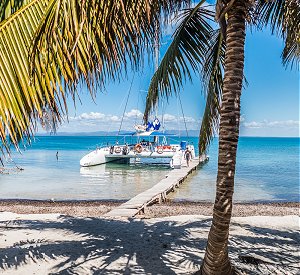 It took two hours sailing through tropical waters to get to the Island. The island is all white sand beaches, waving palm trees, sweet hidden coves, and enticing tropical water. It is also inhabited by many iguanas and hutias. Neither the hutias (a large rodent endemic to Cuba) nor the iguanas seemed aggressive, or even that much interested in us at all. The sea was a perfect turquoise, the sky a perfect azure, the sand soft underfoot. We sank down in this tropical paradise entertained by our serene surroundings and the very active wildlife and rich birdlife.
It took two hours sailing through tropical waters to get to the Island. The island is all white sand beaches, waving palm trees, sweet hidden coves, and enticing tropical water. It is also inhabited by many iguanas and hutias. Neither the hutias (a large rodent endemic to Cuba) nor the iguanas seemed aggressive, or even that much interested in us at all. The sea was a perfect turquoise, the sky a perfect azure, the sand soft underfoot. We sank down in this tropical paradise entertained by our serene surroundings and the very active wildlife and rich birdlife.
From Trinidad we completed the circle by returning to Havana for another day before our flight home. It was an amazing time visiting a country that in many ways seems stuck in the past. It’s a country with heartbreaking poverty, very friendly people, and the soul of a musician. Don’t miss it!
I have heard from two reliable sources that it is easy for Americans to enter Cuba from Canada or Mexico.

Leave a Reply